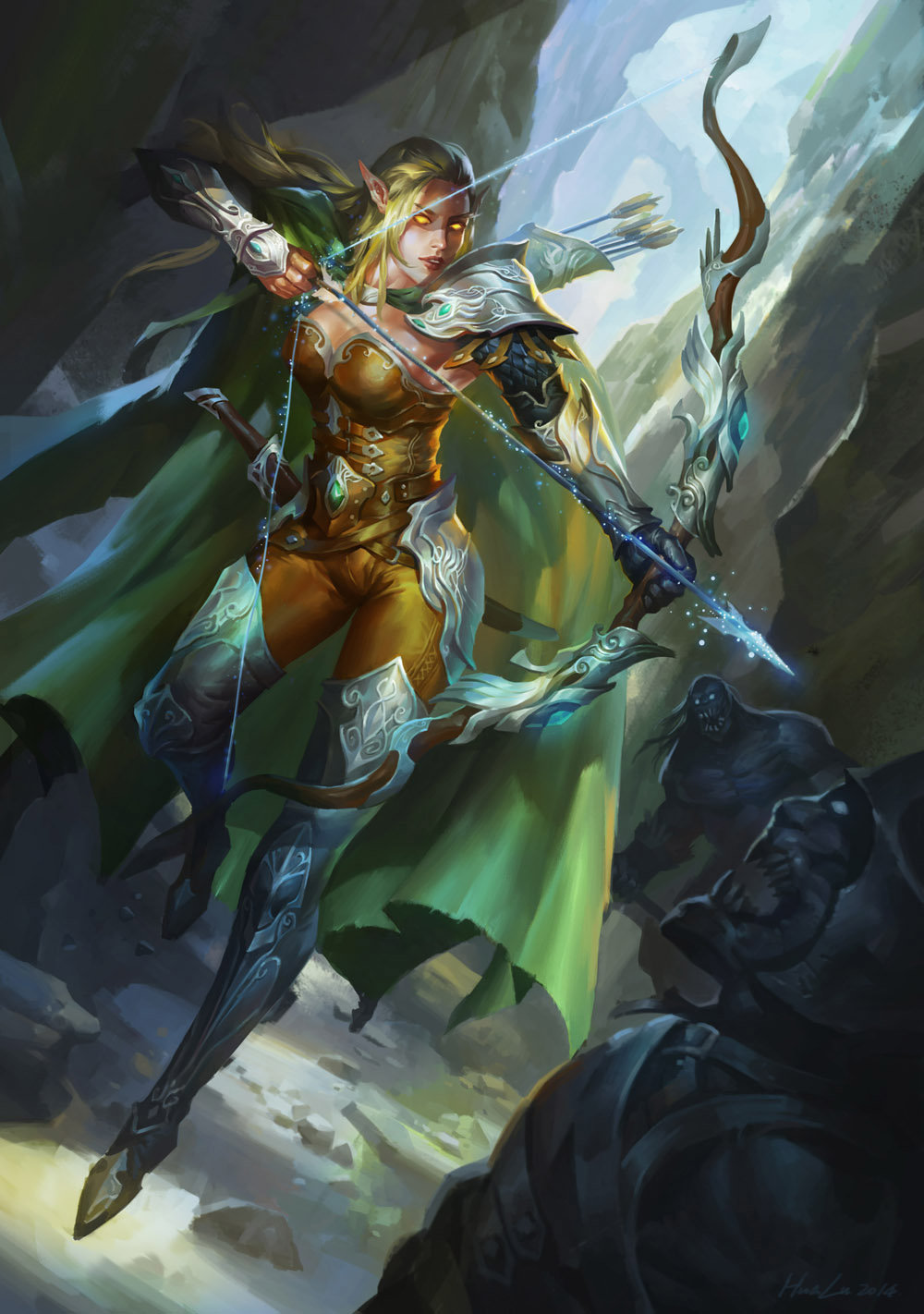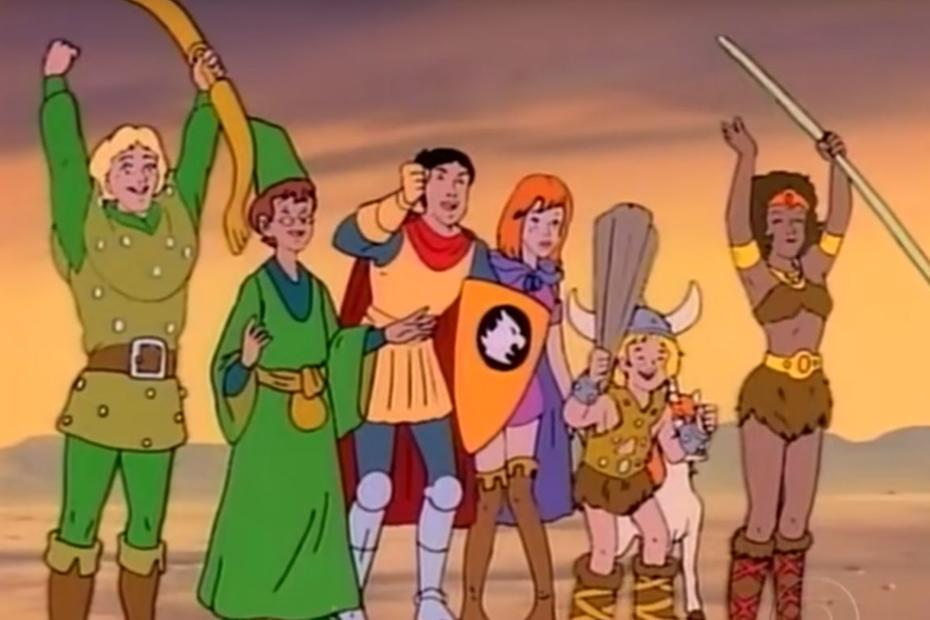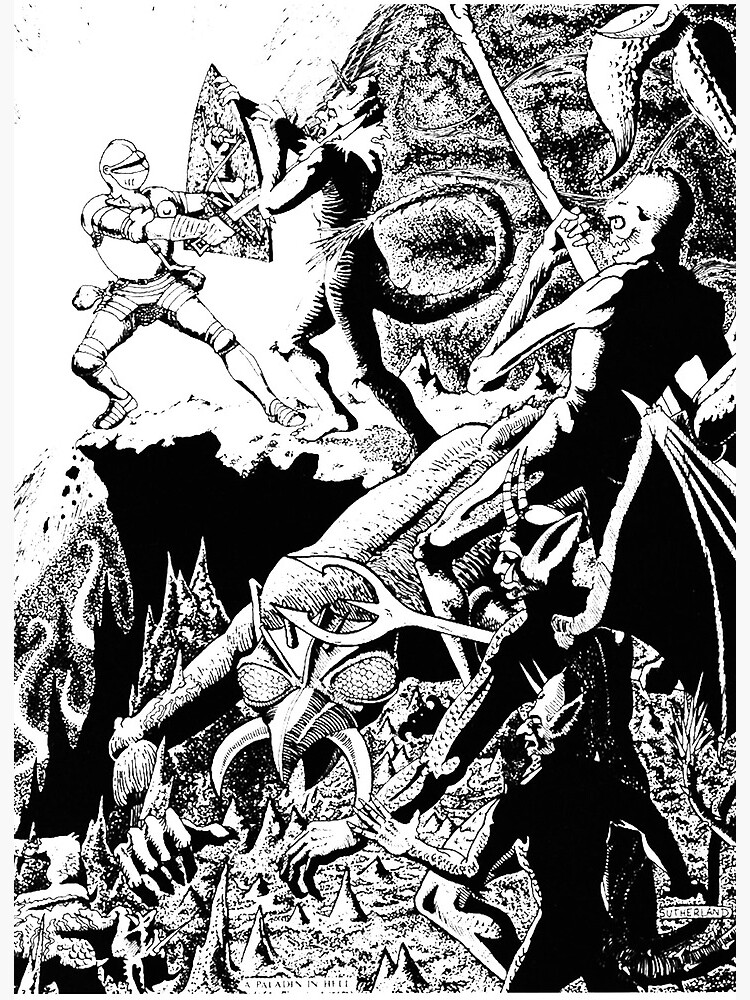Appraising ADVANCED D&D - Part 4 (Classes Addendum: 1e comparison)
I started doing some 1e comparisons when I wrote the previous entry, but it quickly grew out of control and I decided to section it off, so that 2e classes also get to be compared on their own merits. That said, let's look how classes stack up in 1e vs 2e:
What has been left out from the accumulations of classes from 1e? Monks and Assassins were in the 1e PHB and dropped. Thief-Acrobats, Cavaliers and Barbarians introduced in Unearthed Arcana didn't make the cut either.
I say to all of this - Good riddance. Let's take a closer look:
- Monks. Mechanically, Monk was probably the shittiest class ever devised for D&D, and conceptually too marginal to merit being salvaged for 2e. Are 3-5e really richer for bringing it back? I think not.
- Assassins! The original edgelord class. In Gygax' own words, "The anti-thesis of weal." Bleeeergh. Having a core class that must, by the book, be of evil alignment in your core rulebook is just a recipe for bad group dynamics, if at all allowed.
Assassins as a class are fine as a Dragon Magazine insert, for those who'd like to try it. But it has no place in the core rules.
The fact that assassins only ever seemed to also be half-orcs only completes the image of a one-dimensional anti-social edgelord class. Shouldn't you be playing V:tM?
- Thief-Acrobats, Cavaliers and Barbarians. 2e correctly determined that these are merely minor variations of other classes and relegated them to kits. I approve wholeheartedly. Cavalier in particular really fucking squeezed the conceptual space on the fighter-cavalier-paladin-cleric spectrum. How many knightly type classes do we need? And barbarians as fiercely anti-magic savages were always a weird take.
Regarding the core classes: Thieves in 2e now get to allocate points to their thieving abilities rather than follow a fixed track. Since this is Advanced D&D, I approve of the change. Fighters and wizards are basically unchanged.
Let's dwell a moment on clerics and druids. In terms of class construction, they are more or less the same. 2e allows druids to progress beyond 15th level as Hierophant druids, though with a monstrous XP cost of 500k per level. 1e gives druids HD all the way up to 14th level.
The main difference is spells. Spell lists and spell slots.
Spell slots - Clerics and druids in 2e use the same spell slot table. 7th level spells come online at 14th level. In 1e, that was 16th level for clerics and 12th level for druids.
I updated the XP comparison table from the previous entry to 1e. Let's take a look and translate this to XP
The 1e druid gets 7th level spells at 300k XP and the cleric at 1.8m XP. An absolutely monstrous difference. And here we find the true nature of the Druid design revealed. By far the least XP requirements to reach 12th level (except for the bard, but we'll get to that below) where the class basically maxes out as you reach "Druid" level. Except, there are only nine 12th level druids in the world, three 13th level arch druids and one 14th level grand druid, above which advancement is not possible.
1e is more sparse in detail on how advancement happens with such limited numbers than 2e, to it detriments I feel. The detail we get in the 2e PHB on druidic ranks really embeds it into the world in a way that the 1e skips a bit too lightly over, given how consequential this is to gaining levels.
But the basic gimmick of the druid seems to be that they are the fastest advancing spellcaster by far, and once they plateau they plateau hard. 12th+ level doesn't seem to be much of a playable option for most druids really.
I don't know how I feel about this, to be honest. On one hand, I kinda like that cleric and druid spell progression is asymmetric. But the combination of Druids advancing to 12th level much faster than clerics and having 7th level spells four levels earlier than clerics is just a bit too much. It feels like a "fuck you" to anyone stupid enough to play clerics.
So the verdict is in: 2e takes this round, despite the more boring approach of using the same spell progression table for both classes and the overlap of spell lists. The difference in XP still means that 2e Druids get to 6th level spells much faster (200k vs 675k) but clerics actually get marginally quicker access to 7th level spells (1.35m vs 1.5m) which is actually an interesting differentiation. And the details on druid advancement, as well as the possibility of advancing beyond 14th level, makes it a more wellrounded build.
 |
| Larry Elmore comes in from the right and draws a swift victory for 2e in this round. |
Let's dwell a bit on this XP table, now that we're here. As with 2e (which mostly inherited these tables, except for ranger/paladin, bards and illusionists), they have the same weird curve where fighters need more XP than magic-users from 8th to 13th level. At 400k, the MU is 11th level, whilst the fighter is 9th level. What's up with that?
At 8th and 9th level, illusionists need more XP than Magic-users before dropping to lower requirements again. From 8th to 13th level, clerics require more XP than either, before again dropping below both for the remainder of their progression.
Paladin though, shows that their over-poweredness was well reflected in their XP progression. Only the monk, weirdly, competes at mid levels, for heftiest XP cost to level. Let's add a yellow color to show second-costliest XP progression per level (and ignore bard for this exercise)
I actually kinda like how this jumps between four different classes over the course of 20 levels and how different classes at different points overtake each other before droppping back. A little asymmetry never hurt anyone. Alright, enough charts, let's get back to the actual classes.
 |
| No. We're not reviewing any rangers from THAT edition today. |
Paladins are basically unchanged, except their XP cost is a bit reduced. I don't think that's a good change.
Next there's rangers, illusionists and bards - The classes that saw the most change in 2e.
Rangers
1e rangers can track and have favored enemies like in 2e. Except 1e rangers have a pre-selected "Giants" enemy which includes goblins and kobolds (lolwut) whilst the 2e ranger must choose one, with a narrower range. Points to the 1e ranger here. The pre-selection tells us something about the AD&D game world and the place rangers have in it.
1e rangers have improved chances to surprise and are less able to be surprised. The 2e ranger can Move Silently and Hide in Shadows. Same general theme, different mechanics. I think I actually like the 1e implementation better.
1e rangers actually get both wizard and druid spells, as opposed to simply clerical spells. Still weird as hell and even less explicable. Rangers walking around with spellbooks? WHY GARY?
They have a unique class quirk - they start with 2d8 in HD. Which means that on average, the fighter only pulls ahead of them in hit points at level 5. Whilst I find the asymmetry charming, I don't really get what Gygax is going for here.
If you used Unearthed Arcana, fighters finally get a bit of a boost with the new weapon specialization rules, except rangers get them too, because HA HA fighters can't have nice things.
Stuff 2e rangers get that 1e ones don't: Animal Empathy (YES) and two weapon fighting as long as they are in leather or less (kinky shit) and their followers are likely to be animals (YES).
Overall, the victory goes to 2e, though I'd backport the favored enemies and consider backporting the surprise benefits instead of thief abilities.
Illusionists
The illusionist is far more interesting in 1e. No question. Because specialist wizards in 2e suck donkey ass.
The separate spell list only going to 7th lvl (yet including some spells that were 9th lvl for magic-users) with a number of unique spells made them more interesting and flavourful. 2e here took a step towards the bland standardisation of 3e+, where all spells are the same level, regardless of which class is casting them. A pity.
As an example, in 1e Phantasmal Force is a 3rd lvl spell for a magic-user in and a 1st lvl spell for an illusionist. That's a very tangible difference between the two classes that isn't compensated by simply getting an extra spell slot pr level. Here the critiques of commodification and standardisation prove somewhat true. I'd much rather play a 1e Illusionist than a 2e one.
That said, the best take on a distinct illusionist class actually arrived in the most unlikely of places: the Beguiler class found in the 3.5 Player's Handbook II. But that's a topic for another day.
Verdict? use the 1e class if you want to play an Illusionist.
 |
| Prestige class bards come with a certain art direction. |
Finally Bards, aka the original prestige class. Yes, that does mean that if you like bards in 1e, you are secretly gay for 3.5. And it is even more awful than what that makes it sound. Truly. Let's spell out why.
To become a bard, you first had to locate the class at the back of the PHB in appendix II, because it's optional, pending DM approval. That probably also tells you how iffy Gygax felt about the class in the first place (he should have given assassins the same treatment, tbh).
Then, you had to be a 5-7th lvl fighter, then 5-9th lvl thief. Then you had to meet the ability score requirements (STR 17, CON 10, DEX 17, INT 12, WIS 15, CHA 15) and only then can you become a bard. Truly a prestige class among prestige classes.
Besides being a mid-level fighter/thief, Bards gain
- druid spells
- charm ability
- legend lore
- more languages
- party buffing and
- magic item recognition.
Which is cool and all. It's a nice selection. But that's not what they are really about. Their real deal is Hit Points. Oodles of them.
You see, their HD stacks on top of prior class HD from the get go. Say you spent 26k XP to qualify as a Bard as soon as possible (5th/5th fighter/thief). The other fighter in the group at 26k XP is still 5th level. So nothing lost for the bard playing catch-up, once he got to 5th level fighter.
At 30k XP, the other fighter is still 5th level. But the bard has now added three levels of bard on top, with three more HD than the 5th level fighter (and of course, all the special abilities of the bard, 5th lvl fighter and a 5th lvl thief).
Bards in fact have the lowest XP requirements to level up in the game. Factoring in the XP requirements for fighter and thief levels may slow that down a bit, but they soon catch up. The Bard that went fighter/thief 5/5 is the first to reach 11th level with 176.000 XP (including the XP required for those 5/5 levels). 25k less than the Druid.
If the bard maxed out fighter/thief to 7/9 levels, it waits a bit longer but still becomes the first to reach level 12 with 374k XP. At that XP total, our single-classed fighter is still only 9th level. Two levels higher than the lowest of the bard's classes.
That Bard reaches level 20/9/7 with 1.970.000 XP. With 7d10 HD + 12d6 HD + 12 hp.
That's an average of 93 hp. The fighter with equivalent XP is 15th level and has an average of 68 hp. A 15 point difference, or 37% more HP for the bard.
And that's before factoring in CON bonuses, where the Bard harvests a HP bonus from 19 HD, as opposed to 9 for the single-classed fighter. That's 10-20 more hit points for the bard with 15-18 Constitution compared to the equivalent fighter. Oof. Bards are bags and bags and bags of hit points.
Bards are the Delta Force class of 1e. A hard road to qualify, but massively overpowered once they get going.
Half-elves can be bards, except they can't because they are not allowed to dual-class (or, as 1e elegantly calls it, "The Character With Two Classes") as required to become a bard. Shoddy stuff, Gary. And good luck resolving that, 1e-BtB fundies.
The original bard, appeared in the Strategic Review #6 and is actually quite similar to the 2e bard. It makes one wonder why Gygax decided on this strange class design for the 1e PHB, which can't have been playtested much, if at all (Narrator: "It wasn't playtested").
In Dragon #103, Gygax details his vision for 2e, and on the ideas board was making bards playable from 1st level. A resounding refutation of a failed class build, all things told.
Wrapping up
 |
| Maybe the real treasure was playing TSR DnD all along. |
1eLords will claim that the 1e classes were better or, at any rate, had more charm (the first telltale sign of an intellect on the cusp of defeat) in 1e because they were more idiosyncratic and 2e classes are too standardised.
So how much of this is nostalgia-addled minds clawing for the upsides of messy and poor class design and shoddy organisation and how much is simply good non-streamlined design?.
You see, I actually agree with the standardisation critique to a certain extent.
All specialist wizards following the same mechanical implementation is dull as dishwater.
And there is no a priori reason why all classes must progress one HD per level. It's just that, looking at the actual implementation, I don't see why you would do it differently either, as with the ranger.
Speaking of charm, a big loss compared to 1e is the loss of level titles. I know they have no mechanical significance and the quality of it surely could be improved in many places. Nonetheless, it is to me one of the most D&Desque things one can do and it saddens me that the last of the TSR editions omitted them.
I consider it a bonus in 2e that it has fewer classes and resolved the variations with kits. Class design should point to something fundamental. I don't need a new class to differentiate a savage fighter from a noble one (adios, barbarians and cavaliers. See you in the Complete Fighter's Handbook where you take your rightful place as kits).
Unearthed Arcana in particular took the game in a bad direction in this regard (and yes, if you liked Unearthed Arcana, it does mean you are secretly gay for Skills & Powers), but even just across the core rules, I like the 2e set better.
The 1e Illusionist is sorely missed in 2e compared to specialist wizards. The best ranger is somewhere in between the two editions, with more leaning to the 2e ranger. And that's it.
It can not compare to the massive leap 2e made with specialty priests, the toolbox for tweaking spellcasters introduced with Spheres and Schools, the consolidation around core classes, free of fringe classes like monks, assassins, thief-acrobats, etc. And of course, how much better they are organised and presented in print. Even though the 2e organisation is dated today, it's streets ahead of the morass that is the 1e ruleset.










Hierophant Druids were introduced in 1e as part of Unearthed Arcana.
ReplyDeleteI have somehow completely excised that from my memory. thanks!
DeleteW.r.t. the bard:
ReplyDeleteThe bard is not a dual class character. It can be compared to the mechanics of dual-classing, but it is NOT a dual-class character. In effect, the progress in fighter and thief classes is similar to the "negative character levels" of cavaliers and magic-users presented in the Unearthed Arcana; once achieving "bard status" the character is simply a bard, albeit one with bonus HPs, a fighting ability equivalent to its highest level of fighter, and thieving ability equivalent to its highest level of thief.
In theory, a human bard could be a dual-classed character with another class.
I disagree. The language in the appendix is clear: you start as a Fighter, change class to Thief, and then change class to Druid, at which point you use the Bard tables instead. The characteristic minima reflect that, sort of, though requiring only 15s instead of 17s in Dexterity, Wisdom, and Charisma (which is one reason that I'm going to use 15 as the required characteristic in the new class for other dual-classed characters). And yes, I do think this implies that the character can't use the old class abilities until rising to the appropriate level in the new class, though that's another restriction I think I will eliminate.
DeleteRegarding the 1E bard: As I read it, the fighter range is 5th-7th and the thief range is 6th-8th. It’s not explicit, but I reckon the intent is the same process as The Character With Two Classes (p. 33): higher level in the second class must be obtained before class functions can be mixed.
ReplyDeleteI’m guessing it was by inference from p. 33 that you imputed the higher D minimum than the class actually stipulates? That doesn’t explain either your raising of the S requirement or your ignoring the standard rule regarding levels for dual-classing.
The full stated prequisites are astonishingly rare enough by Method I that I see no need arbitrarily to inflate them. I would require that the character is from the start enrolled in the bardic program, so there’s no last-minute option to take the dual class (without the 2 more points of dexterity that would normally be needed) and carry on as a thief. It’s bard all the way!